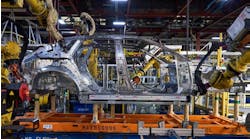It’s pretty apparent the world has a plastic problem, from the 2.6 million tons of plastic debris flowing from rivers into the world’s oceans to the various forms of the transparent refuse that end up in landfills. According to the EPA, Americans created about 14.7 million tons of plastic containers and packaging waste in 2015 alone, which accounted for 5.5% of all municipal solid waste (MSW). The percentage recycled increased from 9% in 2000 to 14.6% in 2015, but more than two-thirds still ended up in landfills.
For the last six years, leading toymaker Hasbro has attempted to mitigate the environmental impact its plastic packaging has had. In 2013 the Providence-based company known for manufacturing Mr. Potato Head and Transformers switched from polyvinyl chloride (PVC), which release potentially dangerous dioxins, to the more easily recyclable polyethylene terephthalate (PET). Three years later the move was made to post-consumer recycled (rPET) and just last year, Hasbro started using bioPET, which is made with plant-based materials.
Now, after all that iteration, and likely supply chain shifting, equipment changeouts, and countless hours of engineering and training, they’re scrapping the whole plan for an even bolder move.
“We’re actually going to be phasing out plastics altogether in our packaging, beginning next year,” says Kathrin Belliveau, Hasbro senior vice president government, regulatory affairs and CSR.
“Even though we made our packaging really sustainable and completely recyclable, in reading the news and testing with consumers, recycling doesn’t always happen,” Belliveau says. Based on their culture and principle “to avoid using unnecessary material” and “reduce environmental impact” in packaging, removing plastic all together seemed the most logical action.
By 2022, the company plans to remove everything from the shrink-wrap encasing Monopoly and Operation game boxes to the polybags inside holding the game pieces, along with the blister packages imprisoning Avengers and Transformers action figures and thin plastic window sheets on Super Soaker boxes. This will only affect new products, not the ones currently on shelves. Two out of every three Hasbro products are new, so the effects should be visible quite quickly.
Though what that looks like is still being figured out.
“We have a very talented team of packaging engineers and designers who are exploring a variety of options for each type of product we create,” Belliveau says. “We look forward to sharing more details, including mockups, in the coming months and years as we continue on our journey.”
The move is part of a broad strategy Hasbro been executing for the last 10 years, Belliveau says. Those marching orders can be summed up as “Leave the world a better place for children and their families” and “doing the right thing,” she says.
That’s the legacy Belliveau says the founding Hassenfeld Brothers left behind, and it’s as embedded in the culture as child-like imagination.
“Sustainability is one of our core values,” Belliveau says. “Doing good to do well is really who we are and everyone we hire has that mindset. Getting people to buy into our values is very easy for us.”
The toy company is completely serious about continuously reducing the environmental impact of its production and supply chain. Almost 99% of their entire electrical use across their facilities were balanced by buying 24,861 MWh of renewable energy certificates (RECs), while 90% of the packaging came from recycled material or sustainably managed forests. They also have a program set up with a recycling company called TerraCycle to convert old toys into building materials for playgrounds and park benches. Hasbro has also teamed with Amazon to create Frustration-Free Packaging, which cut the packaging material for Baby Alive dolls purchased online by 50%.
It’s easy to imagine every employee riding their bikes to work, composting leftover dinners in their backyard, and perhaps even summoning Captain Planet on occasion. But even if all that were true, making sweeping changes of a global manufacturer’s supply chain, one that tackles thousands of new products a year,
“I don’t want to understate the complexity of this kind of initiative,” Belliveau interjects. “There are tremendous challenges anytime you make a bold leadership change in terms of how you design and make packaging.”
She rattles off the potential for toys getting scratched or crushed in transit, and even when safely delivered intact to the retailer, theft prevention is a big concern. Then they must plan changes with vendors and suppliers, all different for the Playskool or action figure divisions. Then add to that all the iterative changes already taken place going from PVC to the new bioPET.
How do you talk even the most devout eco-friendly corporation I to such a move in such a short amount of time?
Belliveau quickly has a response: “Build buy-in at all levels of the company, but first and foremost, the teams that actually have to execute, make sure they understand why are we doing this, how it aligns with our greater business model and core business, and ultimately present this to your CEO or leadership and get them to embrace it.”
But perhaps most importantly, after those steps, the entire company must be in lock-step, all becoming cheerleaders for the cause who recognize the complexities and believe the move is a win-win. If Belliveau and the C-Suite are the only ones touting a green project’s merits, that’s a recipe for failure.
“Sustainability initiatives, to be successful, they can’t be driven out of a corporate office, they really do have to be embraced by the entire organization,” she says.






